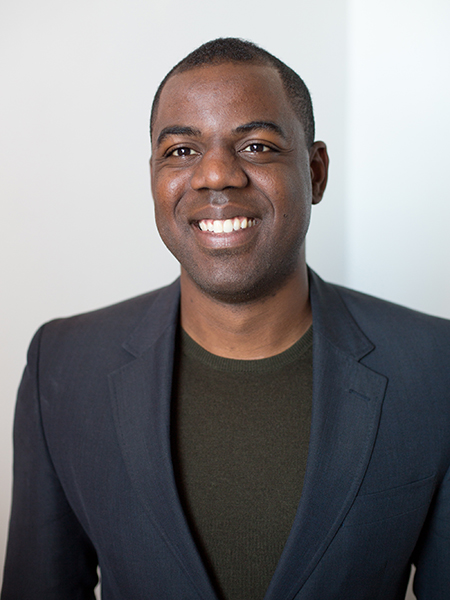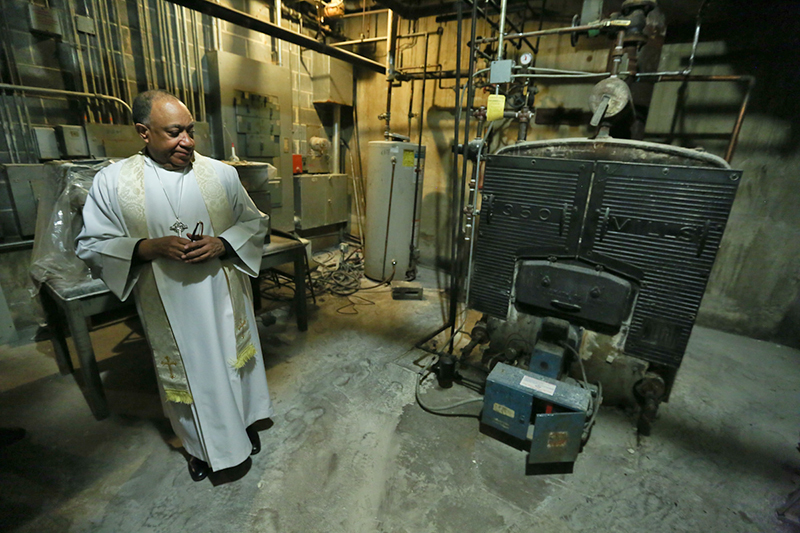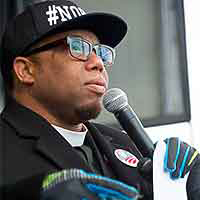America’s inner cities are filled with aging buildings that are notoriously energy-inefficient. It’s a problem that Donnel Baird sees as an opportunity.
Baird is CEO and cofounder of BlocPower, a startup that markets and finances energy-upgrade projects in financially underserved areas.

The native of the Bedford Stuyvesant neighborhood in Brooklyn says his company is meeting a need that would otherwise go unfilled, as many small businesses, houses of worship, non-profit organizations, and other entities are too small to qualify for energy-improvement loans. BlocPower, founded in 2013 with venture capital seed money, bundles these small projects together and sells them to potential investors.
In an interview with Yale Environment 360, Baird — a former consultant to the Obama administration on energy-efficiency programs — describes how BlocPower’s projects not only create jobs and reduce carbon emissions, but also raise awareness of global warming in inner-city communities. He says the program doesn’t distinguish between the community and climate change benefits of the work. “It is not possible for the climate change movement to win anything significant without the participation of people of color,” says Baird. “I view my work as a wholly integrated approach for solving problems with economic development and climate change. I don’t make distinctions.”
Yale Environment 360: Why is there a need for energy retrofits in the area where BlocPower works?
Donnel Baird: We focus on financially underserved communities in inner cities, where I grew up and some of our management team grew up. The buildings in those communities are failing. They haven’t been able to access capital to make necessary repairs and improvements and investments over time, and therefore they are highly inefficient. The same-sized building in a more affluent community often uses a lot less energy then in a financially underserved community. What ends up happening are the owners or operators of buildings in financially underserved communities — a huge percent of their budget ends up going to cover those energy costs because their buildings are so inefficient. In an affluent community, the energy bill might be one to two percent of an operating budget. In a lower-to-moderate income community, in many buildings the energy bill can be as high as 30 percent of the overall operating budget and therefore energy cost is a huge pain-point for these buildings, which makes them a huge opportunity.
e360: What happens if, say, a barbershop in Bedford Stuyvesant goes to a bank for a loan for an energy upgrade or solar installation?
Baird: That’s a short meeting. Nothing happens. They are told that the size of the project is just too small for the bank to consider making a loan. The cost of the bank’s personnel to analyze that barbershop’s financial statements is just too high. The uneven cash flows of a barbershop may often not be financeable for a bank.
If you bundle those 100 barbershops across Harlem, that is a much easier project for a bank to finance.
More broadly, the projected savings that an energy-efficiency or clean-energy retrofit might generate are not something that the small business arm or the renewable energy arm of the bank can project. They can do it for a huge utility-scale solar power plant in Arizona. They can’t do it for a small business, synagogue, or community center, or even for schools in these communities.
e360: BlocPower can?
Baird: BlocPower can. The financial and engineering services that are unavailable to that barbershop are exactly what BlocPower is set up to provide.
e360: Describe the bundling mechanism that’s the linchpin of how BlocPower operates and what that mechanism gets you.
Baird: We learned about the bundling mechanism through conversations with Goldman Sachs and Barclays Bank. Senior investment bankers from their teams provided pro bono feedback on our business model. Instead of financing one $5,000 to $10,000 barbershop at a time, if you aggregate or bundle those barbershops into 100 barbershops across Harlem, that is a much easier project for a bank to finance. Bundling the projects increases the size of the project, which makes it more interesting to banks. It increases the performance of the project by diversifying the pool of borrowers, allowing you to offset any losses that you might have from one borrower against great payments from another borrower. It decreases risk and increases transactional size. We think, and these investment bankers and Wall Street think, that the pooling and bundling mechanism is the way to bring clean energy and energy efficiency to underserved communities.
e360: How small can a project be and still qualify for bundling, and how large a portfolio do you need?
Baird: There is one global investment bank that’s willing to do projects as small as a $500,000 bundle. Generally, we say $5 million is the threshold where folks get interested. In order to participate in that $5 million bundle, there’s no prohibition from the bank’s side regarding what the minimum is for a building that can participate. The question for BlocPower as the aggregator is, can we generate enough savings in that building? Is there enough of a financial history in that building for it to make sense to join a portfolio? In most cases we can. Out of the 400 clients we’re serving, we have never turned anyone away for being too small.

e360: Is it tough to find investors? What’s the pitch?
Baird: We actually have seen that there is an appetite to make investments that have a great impact on renewable energy. Lots of high-net-worth individuals who put their money into banks want to make investments with three percent of their assets for social or environmental good. Of course, there’s a corporate and social responsibility aspect of it as well. And when you’re dealing with financially underserved communities, the U.S. Department of Treasury has a regulation called The Community Reinvestment Act that also compels retail banks to make investments in low- and moderate-income zip codes near the bank.
So we try to mix all those different kinds of capital, those interested in solar, those interested in community reinvestment, those interested in social impact. We try to talk to as many investors as possible to figure out what kind of investors make sense for what kind of project.
e360: Of course the financials have to be there too, right?
Baird: Absolutely. You’ve got to take that as a given. We initially thought that perhaps some of the so-called impact investors, those looking for social and environmental impact, might be willing to take a little bit of a financial discount in exchange for reduced carbon emissions or increased job creation. We just haven’t seen that be the case yet, which is unfortunate.
e360: How big a role does solar installation play in the retrofits that you’re doing?
Baird: It varies. Ninety to 95 percent of our projects are in New York City, where solar is more challenging due to the roof-to-building ratio size.
These projects will generate a significant amount of energy savings, often as high as 50 percent.
Although in the outer boroughs there is a significant opportunity for solar.
So solar is secondary to the energy-efficiency analysis. But it is extremely important, particularly when you combine solar with energy efficiency because that is what generates the kind of electricity bill savings and energy savings that make the total package attractive to customers.
e360: Repayments to BlocPower are collected by the utilities. Are they based on actual energy savings?
Baird: They’re collected by the utilities, but they are based on the loan that the customer accepted. Our customers are receiving great high-efficiency heating systems from the Netherlands or new boilers from Japan. Those are huge investments being made on their property. Again, these are properties that no one else wants to invest in. We project energy savings and we feel an extreme level of confidence that when we install these projects, they will generate a significant amount of energy savings, often as high as 50 to 60 percent. But that debt needs to be repaid and is not conditioned on the energy savings.
e360: What’s your limiting factor right now: investors or those interested in having upgrades done?
Baird: It’s our corporate investors. It’s folks who are willing to provide seed capital to clean-energy companies. Those kinds of venture capital investors have really taken a beating. Clean tech is still a dirty word even out in Silicon Valley. Clean tech companies are just not seen as great investments across the board. And so that access to seed capital to grow and expand our business has been challenging. With that said, we are very fortunate that leading venture capitalists in Silicon Valley have invested in our company.
e360: Tell me about one project that you think exemplifies what BlocPower can accomplish.
Baird: We’re doing a project with a hospital system in the Bronx that has identified the buildings that produce really high childhood asthma rates.
The hospital is focused on lowering asthma rates, and it turns out that buildings can cause asthma because they have mold, because they have particulate matter, because they have inefficient ventilation systems or boiler systems. So the hospital has targeted which buildings in the Bronx are causing asthma in kids. We’re partnering with the hospital and an investment bank and faith-based community groups to reach out to those property owners to retrofit those buildings, to not only bring down energy costs, carbon emissions, and saving the building money, but also lowering asthma rates and keeping kids in school and parents at work.
That’s the kind of multiple impact that we’re super-proud of.
e360: You’ve got a 60-building public housing retrofit in Brooklyn that has its origins in a failing grid infrastructure. Describe what’s going on there.
It’s important that the community also participate, and not in a meaningless way.
Baird: The neighborhood where this is occurring is the lowest-income neighborhood in Brownsville, Brooklyn. The electricity grid is failing and is at risk of rolling black outs. [New York] Governor [Andrew] Cuomo, to his credit, instead of allowing the utility industry to continue to invest another billion dollars in the fossil fuel infrastructure to upgrade this piece of the grid, encouraged the utility company to make clean-energy and energy-efficiency investments to lower energy consumption.
We have a contract to develop a set of solar panels, large batteries to store electricity, and other energy-efficiency retrofits that would allow this community to own and operate the clean-energy infrastructure that’s being installed in their neighborhood. And because they will produce so much electricity through this project, they can sell a lot of that electricity to the local utility company. Part of that cash dividend will be redistributed to community residents who can make repairs in their buildings.
As we make these investments we think it’s important that the community also participate. And not in a meaningless way, but participate as formal, equity owners of the multi-million dollar clean-energy assets that are being installed, and that they be trained on how to operate these solar panels and batteries systems.
What that does is give low-income residents in low-income communities a stake in the climate change movement, instead of being passive recipients of the advocacy work of others. They’re learning how to modify their own energy consumption because it’s going to generate a little extra income for themselves or their family or their building. In doing so, what we hope is that they’ll become engaged in the broader climate fight.
e360: You mentioned jobs creation is another component in BlocPower. How does that work?
Baird: We require the installation companies who bid to install our projects — where we can — to hire well-trained people from local disadvantaged populations. We are also starting a nonprofit
ALSO FROM YALE e360Rallying Hip Hop Culture For A More Inclusive Climate Fight

that is focused on training, hiring, and staffing folks from disadvantaged populations to get them trained to install solar panels and energy-efficiency systems so they can have a real career and a real skill set that’s going to get them great wages and give them health care and help them and their families.
e360: You grew up in Bedford Stuyvesant and have a background in community organizing. For you, is this work a community project with an environmental benefit, or the reverse?
Baird: I don’t make distinctions between the two. I am a product of a family that was in a lower-income community and that’s something that’s very important to me. And I am someone who unabashedly believes that we’re in danger of ruining the planet. And I do not think that it is possible for the U.S. climate change movement to be successful without the participation of people of color. So I view my work as a wholly integrated approach for solving problems with economic development and climate change. I don’t make distinctions there.
e360: Would it be easy to take this model throughout the country, or are there impediments?
Baird: There are always impediments. We’re a public-benefit corporation, but we’re a venture capital-backed startup and our business model is designed to expand rapidly to every inner city in the country. That’s the ball game we’re playing. We hope to be in 50 to 100 cities by the end of 2017.